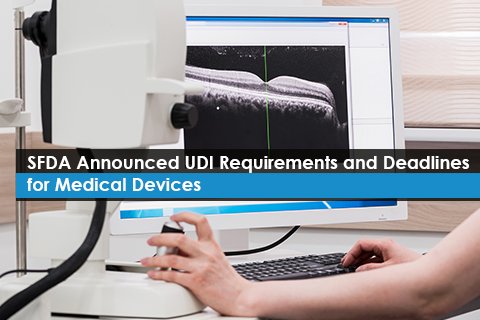It is well-known that Unique Device Identification (UDI) is critical, and if implemented accurately, it will garner major and long-term benefits for medical device manufacturers, healthcare providers, and consumers. The major benefits of UDI include accurate reporting, reviewing, and analyzing of adverse event reports, reducing medical errors with rapid and precise identification of device characteristics, reduction in counterfeiting, better assessment of device performance, informed patient treatment, and providing a standardized identifier that facilitates efficient management of medical device recalls.
However, the key element to achieving these benefits is to follow the specific guidelines issued by various Health Agencies. Recently, Saudi Arabia’s medical device regulator, SFDA (Saudi Food and Drug Authority), released a guidance document stating the revised UDI requirements and compliance timelines. Let’s see what the guidance document entails.
The Guidance Scope & Purpose: On the first note, the SFDA UDI guidance applies to:
- All medical devices and their accessories that will be supplied to the KSA market, except for medical devices and IVDs used for research or investigations, and custom-made for a specific patient
- Manufacturers, authorized representatives, and importers
In general, UDI aims to increase patient safety and optimize patient care by facilitating:
- Identification & control of medical devices during their life cycle
- Identification & traceability of medical devices in adverse events and field safety corrective actions
- Safe and effective use of devices and reduction of medical errors
- Documentation and longitudinal capture of data on medical devices
The purpose of the SFDA’s UDI system is to provide standardized identification of medical devices and their accessories and associated device-specific metadata to support numerous and varied public health and safety initiatives, which include:
- Device traceability
- Identification of counterfeits, recalls, adverse event reporting
- Inclusion of specific devices in various types of clinical information systems (such as patient records), and
- Inclusion of device information in population-based data sets, such as insurance data
UDI Requirements and Deadlines
- The manufacturer shall assign and manage the UDI by following the chosen issuing Agency’s specifications, standards, and guidelines.
- UDI marking is an additional requirement, and it won’t replace any other marking or labeling requirements.
- GS1, HIBCC, and ICCBBA are the provisional UDI issuing Agencies.
- The UDI shall contain two parts: the UDI-DI and the UDI-PI(s). The UDI -DI is unique to a specific manufacturer’s device and provides access to information in the Saudi-DI database. If a label or package includes a lot number, serial number, batch number, software identification, and expiration date, it shall be included in the UDI-PI.
- The label of the device shall include UDI, and all higher levels of packing shall be presented in easily readable plain-text and AIDC technology.
- The barcodes shall be verified per the appropriate ISO/IEC standards and should meet the issuing Agency’s grading standards.
- A UDI is not required for shipping containers if there are other means of tracking.
- Reusable devices subjected to UDI requirements shall bear a Direct Marking (DM) UDI on the device itself, and it should be permanent and readable during normal use and throughout the intended life of the device.
In addition to the above UDI requirements, the SFDA guidance document has detailed about UDI-DI lifecycle, management of UDI issuing Agencies, and the UDI requirements for SaMD, implantable devices, configurable devices, components and sub-systems, device constituent parts of combination products, and single-use device exceptions. Alongside, the document contains the compliance deadlines as per the devices’ risk classification. According to the guidance, the applicants shall submit all the required data in the Saudi-DI database before the deadline of the device category, as mentioned below.
- For Class B&C (Medium risk) – February 1, 2022
- For Class A (Low risk) – February 1, 2023
Adopting and implementing the above SFDA UDI requirements will bring about significant cost, quality, safety, and efficacy improvements in the delivery and management of medical device-related healthcare. Are you willing to sell your medical device in Saudi Arabia provenance? Is your medical device compliant with the SFDA’s UDI requirements? Contact Freyr for complete UDI compliance. Stay informed. Stay compliant.





